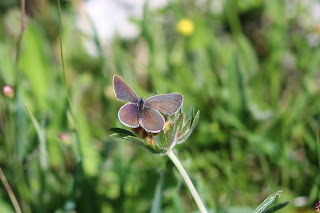A rare wagtail, and an even rarer twitch
I have not blogged recently for several reason. The weather has not been favourable and I have not been seeing much when I have ventured out and about around Clevedon.
This week, though I decided to go and see the Eastern Yellow Wagtail that had been found at Steart marshes last week.
This species has only recently been declared as separate from our own Yellow Wagtails which should, I suppose be called Western Yellow Wagtails from now on. I have no intention of doing so , of course, as its needlessly long, and most of the time, no real confusion is possible with 99.999% of wagtails seen in Europe.
I left the visit until after a weekend expecting a lack of anything resembling a crowd at that point. I was correct in this and turned up at 9.05 am to see just three people at the site. So far so good but the news that the bird had flown off at 9.03 was not so welcome. Still a site stretching over several hundred acres was too big to search so I settled in for a wait. About two hours later I heard the distinctive rasping call that I associate with Eastern races of Yellow Wags and the bird flew in to land reasonably close.
I watched it for about 15 mins and managed to get further along the footpath and thus closer to the bird before it flew off into the distance once more. As far as I know it was not seen well again that day. I stayed for a further 3 hours and certainly failed to see or hear it in that time. The bird was feeding in tracks at the very edge of a huge marsh and was reasonably close to a high bund that held the footpath. Thus there was no risk of anyone disturbing it by approaching too closely.
So how do you identify these birds ? Frankly I find it extremely difficult and expect the taxanomic treatment is far from set in stone.
There is a very detailed paper in Dutch Birding magazine (also available on researchgate ) that covers the complex. I read this the night before but still left home thinking the call was probably my only chance.
OK, the bird is very grey and white, but so are some Westerns, the thin wing bars could fit either. A dark loral area and long supercillium could fit both groups I suspect. Though I never saw the feet well, some photos show a long hind claw which is reportedly a good feature.
Some photos show yellowish undertail coverts, but some don't and I believe this is more a factor of reflections from the ground than a reliable difference.
So that leaves us with the call. I deployed my new toy, the Olympus recorder and obtained, first time two dog walkers earnestly discussing something or other as they passed me without evincing the slightest hint that they had seen me staring through my scope, followed by a single distant, quiet call from the bird. I deleted this as is no business of mine to record other peoples comments.
Secondly, when I had crept nearer I managed to get a clear sequence of calls as it flew off. I have added the recording and sonogram here but my efforts seems too poor to clinch a subspecies.
The problem with calls is their variability. To give examples from my own experience
I have heard a spring migrant Yellow Wagtail in Clevedon give a very very similar buzzy call as it flew over my head. Mind you it also appeared to have a black head and so was probably an eastern race Western Yellow Wagtail, i.e. from Greece, Bulgaria or nearby.
I have heard wagtails in Latvia give this buzzy call but I understand this is typical of Blue-headed wagtail song (which comprises one buzzy note and one clearer note)
I thought last year's local Citrine Wagtail sounded similar and again I picked that up on call before I saw it.
Luckily there are many birders with more acute ears than I and the proliferatio
n of recordings, along with digital cameras will enable us to get to the bottom of such conundrums in future.
I would like to have seen it for longer and will probably return later in the winter if it stays. Until then I am grateful to the finder and also grateful that I saw one in Devon years ago that was identified from DNA.







Comments
Post a Comment